
Copyright © 2010 LITUANUS Foundation, Inc.
Volume 56, No.2 - Summer 2010
Editor of this issue: Violeta Kelertas
 LITHUANIAN
QUARTERLY JOURNAL OF ARTS AND SCIENCES
|
ISSN
0024-5089
Copyright © 2010 LITUANUS Foundation, Inc. |
|
Volume 56, No.2 - Summer 2010 Editor of this issue: Violeta Kelertas |
The Clandestine Burials of KGB Victims at the Tuskulėnai Site in Vilnius, Lithuania
RIMANTAS JANKAUSKAS
VYTAUTAS URBANAVIČIU
ANTANAS GARMUS
Abstract
The paper presents the results of the exhumation, examination, and
identification of the remains of individuals executed in the KGB
headquarters
in Vilnius in the years 1944 through 1947. Archaeologists and
anthropologists exhumed 706 skeletons in 1994 and 1995; 18 more
skeletons were found in 2003. Each skeleton was analyzed according
to routine forensic protocols. Research in the KGB archives and the
analysis of letters of relatives and other documentary data was
conducted
in parallel, and the two data sets compared. In total, 720 males
and 4 females, ranging in age from 19 to 66 years, were found. During
cross-matching of individual data from the KGB files, skull/portrait
superimposition and DNA analysis, 50 individuals were identified.
The details of the executions, the handling of the bodies, and the de92
position of the bodies were also elucidated: individuals executed in
the late autumn, winter or early spring of 1944/1945, 1945/1946 and
1946/1947 were inhumed in a former garage (later demolished), because
the ground inside was less frozen and easier to dig during the
cold season. The construction of inhumation pits and their regular
position prove the planned manner of the executions. Individuals
executed
in the summer of 1945 were inhumed outside the garage footprint
in a separate row of 8 pits, where the bodies were covered with
corrosive disinfecting chemicals.
Introduction
In recent years, a relatively new discipline of forensic anthropology, defined as the application of the science of physical anthropology to the legal process, has emerged in Lithuania.1 The exhumation and forensic investigation of recent mass graves2 are related not only to legal procedures, but to humanitarian needs as well. The objectives of such forensic efforts are twofold: first, to determine the manner of death and, if possible, to identify the remains of recovered individuals and, second, to bring closure to living family members, in support of human rights for both the deceased and the living. Based on this experience and taking into account these objectives, guidelines for such exhumations are also elaborated.3
Forensic anthropology in Lithuania dates from the early nineteen sixties,4 with the experience gained from the exhumation of mass graves from the period of the Holocaust, the examination of a series of historical figures, and numerous forensic osteological and paleoanthropological works. However, the exhumation, subsequent analysis, and identification of individuals buried in the mass grave at Tuskulėnai were a challenge to previous experience as well as currently available skills and resources.
At the end of the Second World War, Lithuania, along with all of Eastern Europe, fell under the dominance of a brutal oppressive system. In Lithuania, strong resistance against the Soviet Communist regime had already begun by the summer of 1944, and armed resistance continued until 1953.5 The regime implemented its system with massive deportations of “unreliable” persons and their families, conducted military operations that caused numerous casualties, and imprisoned and executed participants in the resistance and even potential supporters. The result was a series of multiple clandestine burials at various sites. One such site was the area of Tuskulėnai, close to downtown Vilnius. From September 28, 1944 until April 16, 1947, a total of 767 people were executed (seven more died before their execution) in the NKGB/MGB prison, in accordance with rulings by a USSR military tribunal and special sittings. The majority (613 people) were charged with treason, and sentenced under Article 58 of the RSFSR Criminal Code (“betrayal of the motherland”). The executions were carried out by a special group of NKGB/MGB staff. After the executions, the corpses were buried secretly in mass graves at the former estate of Tuskulėnai. The details of the executions and the locations of burial sites were kept secret under the Soviet regime.
In 1994, evidence about these events became available to the officials of the Republic of Lithuania. Decree No. 216 of the President of the Republic was issued on January 25, 1994 and, accordingly, a working group of archaeologists, anthropologists and forensic medical experts was formed. The initial goal was to exhume and identify two prominent members of the Roman Catholic Church and anti-Soviet resistance. Exhumation and identification work began in June 1994, with soldiers of the regular army aiding the working group. During the field seasons of 1994 and 1995, 706 skeletons were exhumed. In the summer of 2003, eighteen more skeletons were exhumed during the construction of a memorial to the victims, raising the total number to 724.
The aim of this paper is to present and discuss the process and results of the exhumation, analysis, and individual identification of the victims.
Materials and Methods
Each skeleton was exhumed individually by professionally trained archaeologists and anthropologists, given a registration number and, after initial examination and completion of standard field forms, transported to a forensic anthropology laboratory. In the laboratory, every skeleton was analysed according to routine protocols for the collection of post mortem evidence, estimating sex, age and stature,6 and noting such individual traits as healed traumas, traces of disease and its treatment, dental status, and perimortal lesions. At the same time, ante mortem evidence was gathered through research in the KGB archives and the analysis of letters from relatives and other documents. Later, the two data sets (ante mortem and post mortem evidence) were compared, because the initial data survey led us to suspect that individuals executed on the same date (as a rule during the night in a special chamber in the KGB prison) would be taken for inhumation at the same time and place.
Results
During the fieldwork, 45 pits were found, each containing from 1 to 154 skeletons. Thirty-two pits were located under a disturbed stone pavement, later identified as the remains of a garage floor (Fig. 1). Eight pits were outside of the garage and formed a separate row (Fig. 2). Five more small pits were later discovered at the northern end of the former garage, approximately at the locations of former doors, where trees were subsequently planted. A summary of the correlations between execution dates and pits is presented in Table 1.
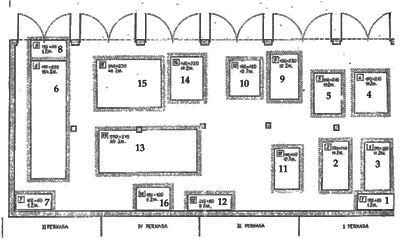
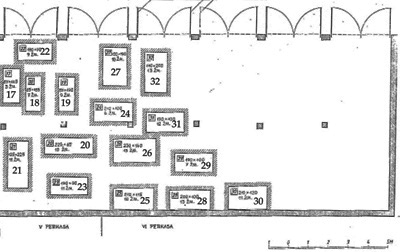
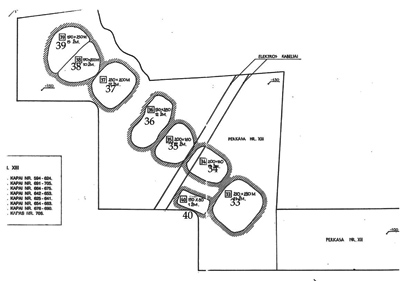
Fig. 2. Schematic
drawing of the separate row of pits found in 1995
indicating pit numbers
(numbers of bodies are in Table 1).
In total, 720 males and 4 females were found, their ages ranging from 19 to 66 years. The positions of the bodies in the pits (Fig. 3) clearly indicate a neglectful disposal of bodies. The overwhelming majority of the skulls of the deceased – 97 percent – had perimortal lesions. In 492 cases, the lesions were caused by one bullet (Fig. 4), in 110 – two (Fig. 5), in 31 – three, in 13 – four, in 4 – five, in 2 – six bullets (Fig. 6). The calibre of the bullets varied from 5.6 to 9.0 mm, which corresponds with other evidence. In a majority of cases, the shots were directed at the occipital area (more often on the left side), the exit site of the bullet being in the frontal area or face. This is proof that the executioner shot from behind. Multiple shots and bullets impacted in the skull vault (Fig. 7) also prove the application of control shots when the victim was lying on the concrete floor of the execution chamber.
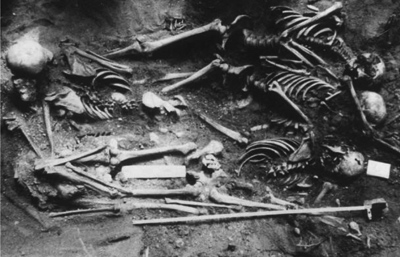
Fig. 3. Typical position
of bodies in one of the pits.
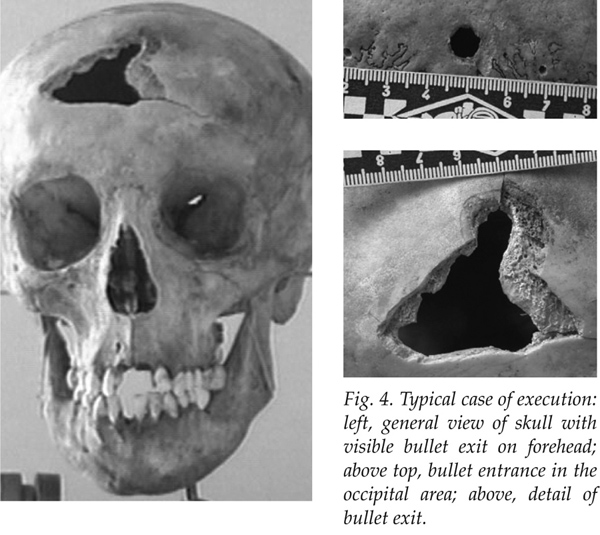
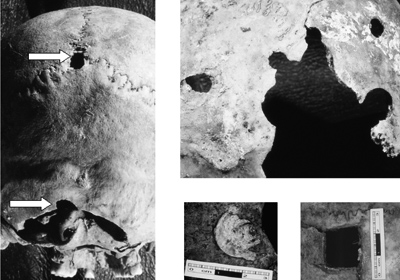
Fig. 5, above left: two
bullet entrances in the occipital area.
Fig. 6, top right: six
bullet entrances.
Fig. 7, above middle: impacted bullet inside skull vault.
Fig. 8, above right:
quadrangular opening (sign of a bayonet?) in skull vault.
Other kinds of skull lesion were also documented: blows by a blunt instrument in 118 cases, stab wounds in 106 cases, and cuts or strikes in 4 cases. The majority of stab wounds were made with four-edged instruments, perhaps with picks or ice axes. (Fig. 8). In 6 cases, quadrangular 3.0x3.0 cm entrance and 0.5x0.5 cm exit holes were found in the skulls, proving that a bayonet was thrust into a victim while he was lying down.
Very few archaeological artifacts were found: some fragments of clothing, eyeglasses, medallions, pencils, etc. In some pits, piles of remaining clothing (mostly winter coats) were found inhumed separately. All of these details of execution and inhumation, together with the use of specific euphemisms in the KGB documents (“kitchen” as the execution chamber, “drop-out of the contingent” as inhumation) indicate clearly a dehumanizing treatment of the bodies, and the excavation of burial pits so close to the city center shows little concern for their discovery.
The KGB files on the executed persons contained information about their age, sex, and approximate stature. Descriptions of faces were frequently given in the files, but this information was often inaccurate and not very useful for further identification. The most important data from the files were the photographs of victims, the dates of executions and the numbers of persons executed in one session. Some additional photos and descriptions were received from relatives of the victims.
The initial comparison of execution details (the periodic execution of several persons, sometimes up to a couple of dozen in one night, with intervals between executions from several days to two to three weeks) and the number of individuals per pit were the basis for working hypotheses for subsequent systematic identifications. It was suggested that the bodies from one execution were transported simultaneously and the people executed during one night buried in one pit. During the crossmatching of data from the reports of executions (the number of executed persons as well as their group and individual identity traits) and a number of bodies with traits that could be significant for identification in particular pits, important details were elucidated about the deposition of the bodies. It became evident that individuals executed in the late autumn, winter, or early spring of 1944/1945, 1945/1946 and 1946/1947 were inhumed in the garage (later demolished) (Fig. 1), because the ground inside was less frozen and easier to dig. The location of this garage was indicated by a preserved stone pavement (a floor) and parts of a foundation. Among the files from the KGB, a letter was found complaining about the difficulties of inhumation in the wintertime. The excavation and construction of the inhumation pits (some of them up to four meters deep, with wooden shoring), bodies lying in several layers separated by tar paper, and the bodies’ regular position, prove the planned manner of these executions. According to this system, individuals executed in the summer of 1945 were inhumed outside the building: in the summer of 1995, a separate row of eight pits was opened outside the garage footprint. (Fig. 2). It is notable that the bodies in these exterior pits were covered with corrosive disinfecting chemicals. Regretfully, the victims from the summer of 1946 were not found.
The next step in the process of identification was to select individual remains for potential identification. The main method was video skull/portrait superimposition. During the cross-matching of data from the KGB files and the video superimposition results, 49 individuals were identified. A list of the persons identified so far is presented in Table 2; it should be noted that this list will be updated as subsequent identifications are made. Examples of positive identifications are presented in Figs. 9 and 10.
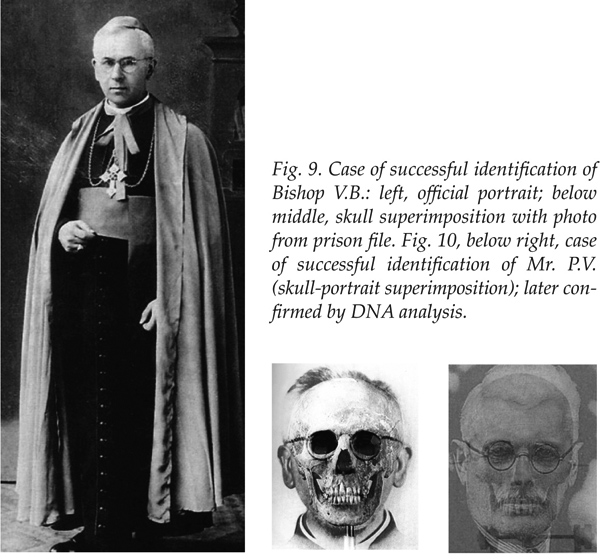
Fate of the Remains
The unidentified skeletons have been
transported to a
specially built memorial columbarium and placed in separate
numbered caskets (Figs. 11, 12). The columbarium was officially
opened in November 2004. Since the potential number of
identifiable individuals is high, further identifications are performed
upon official request. Because the technologies of identification,
especially with the implementation of DNA analysis,
are progressing, this enables the application of these technologies:
in 2007, one victim was identified by DNA examination,
which established that the individual encoded as Case 203 was
the father of two surviving children (a son and daughter) with
a probability of 99.97% and 99.91%; a control sample provided
a definite negative result.
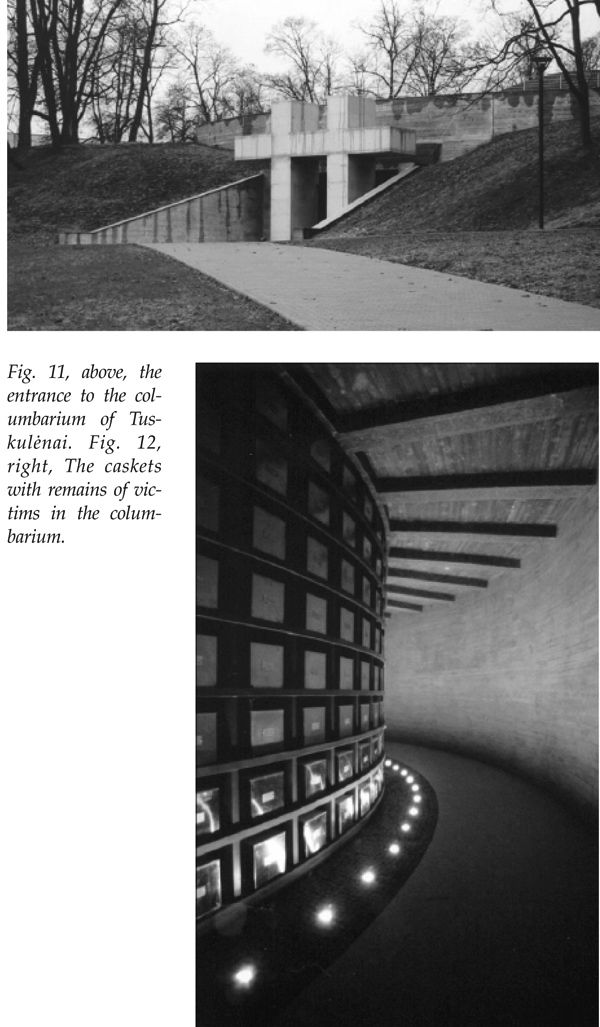
Conclusion
The details of the execution and disposal of the bodies at Tuskulėnai are solid evidence of the attempt by those carrying out this systematic killing to dehumanize their victims, to deliberately destroy evidence of the killings, to deny their responsibility for the deed,7 and to bury the social memory of this violence in order to strengthen the terror-based regime.8 However, it is evident that the close collaboration of professionals from various fields (legal, forensic medicine, and archaeological) is essential to all stages of mass grave investigation and victim identification. Such mass graves are crucial hard evidence about the regime that enable us to understand the technology of terror and to bring back the social memory of these victims.
Table 1
Summary of execution dates, numbers of executed individuals and
identified pits (excavation years 1994 and 1995)
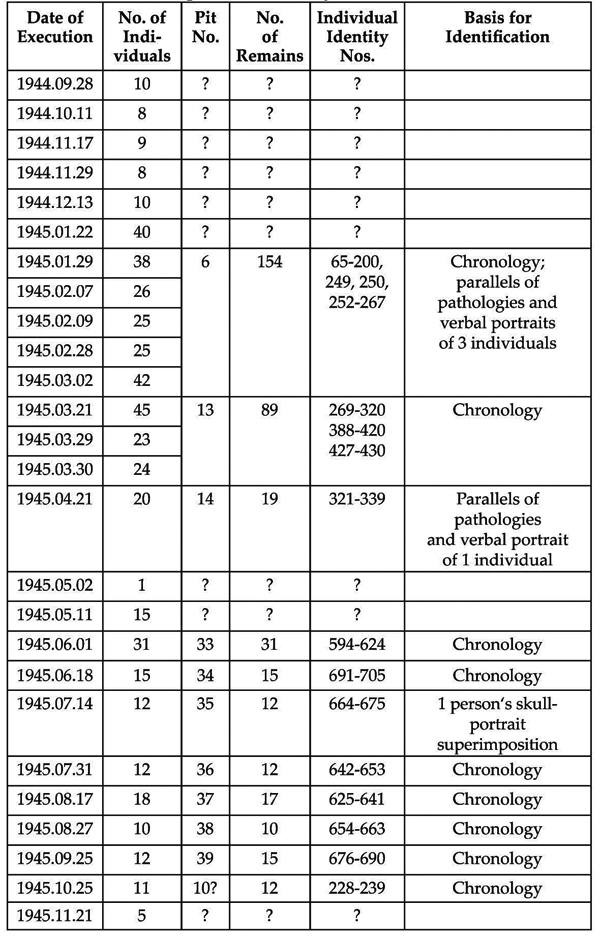
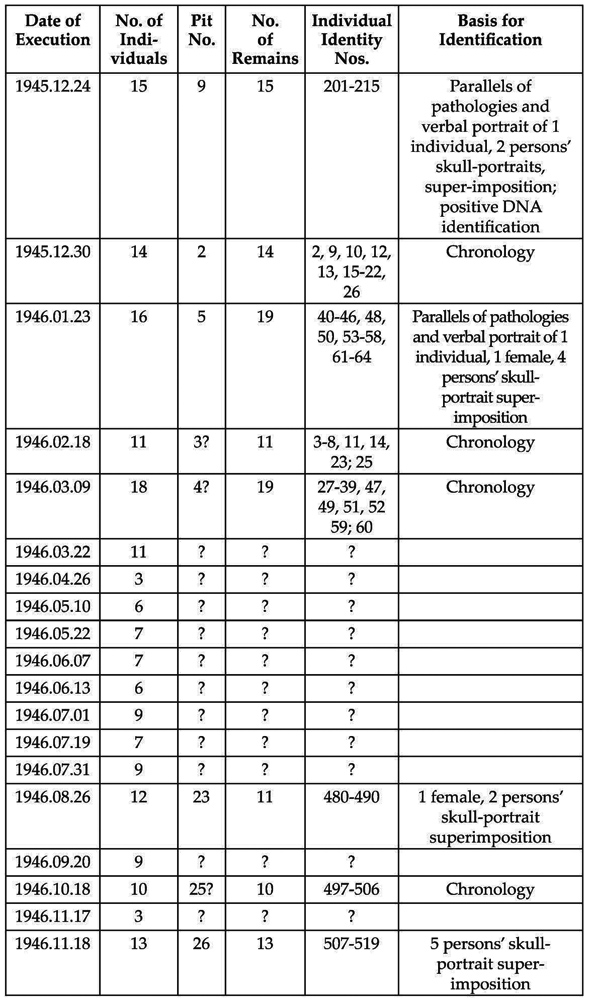
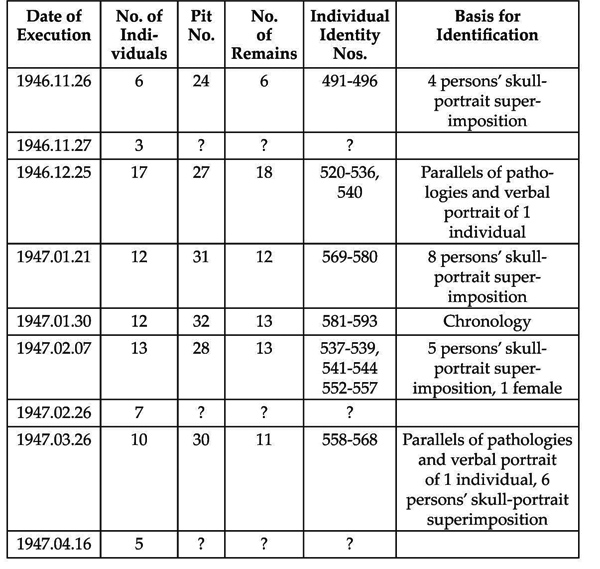 Table 2
Table 2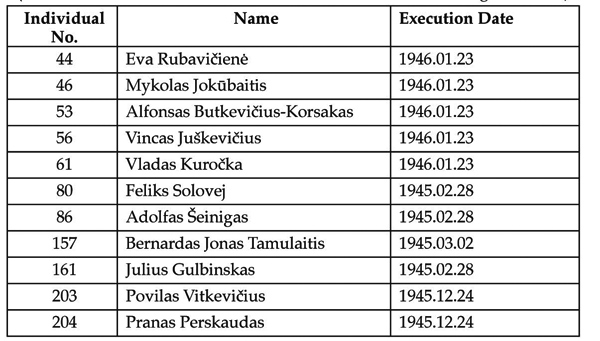
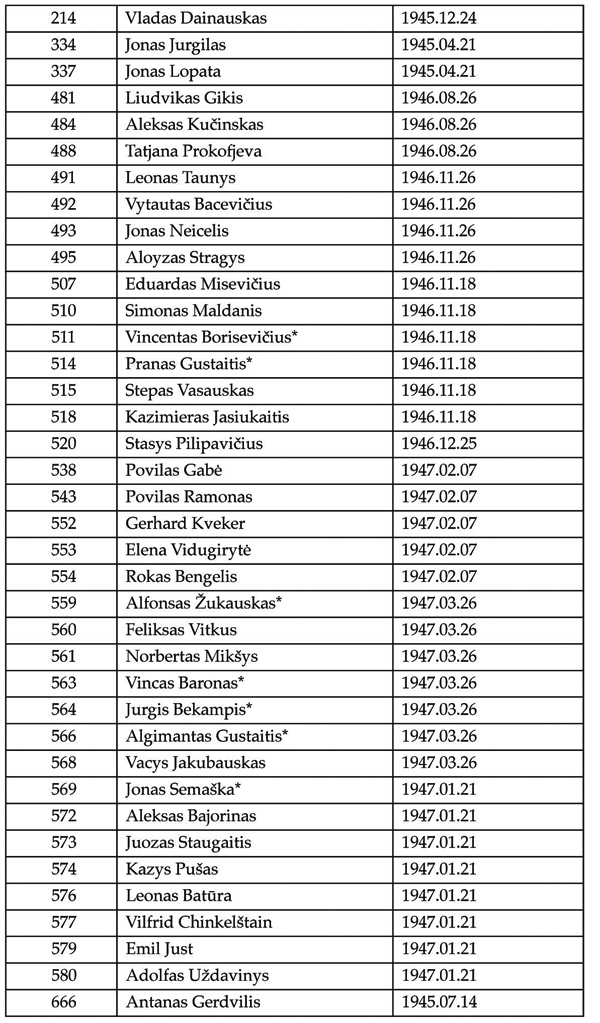
WORKS CITED
Cattaneo, C., Baccino, E. “A call for forensic anthropology in Europe.” Int J Legal Med 2002; Vol. 116, No. 6, N1-N2.
Ferrándiz, F. “The return of Civil War ghosts. The ethnography of exhumations in contemporary Spain” Anthropology Today 2006; Vol. 22, No. 3, 7-12.
Garmus, A. Lithuanian Forensic Osteology. Vilnius: Baltic Medico-Legal Association, 1996.
Garmus, A., Jankauskas, R. “Methods of Personal Identification from a Skeleton in Lithuania.” Medicina Legalis Baltica 1993; Vol. 3-4: 5-21.
Garmus, A., Jankauskas, R., Urbanavičius, V. “Prospects of Lithuanian forensic anthropology.” Acta Medica Lituanica 1999; Vol. 6, No. 3, 238-41.
Komar, D. “Patterns of Mortuary Practice Associated with Genocide.” Current Anthropology 2008; Vol. 49, No. 1: 123-133.
Kuodytė, D., Tracevskis, R. The Unknown War. Armed anti-Soviet Resistance in Lithuania in 1944–1953. Vilnius: LGGRTC, 2004.
Nainys, J.V. Identifikacija ličnosti po proksimalnym kostiam konečnostei. Vilnius: Mokslas, 1972.
Rainio, J., Hedman, M., Karkola, K., Lalu, K., Peltola, P., Ranta, H. et al. “Forensic osteological investigations in Kosovo.” Forens Sci Int 2001; Vol. 121, No. 3: 166-173.
Sjøvold, T. “Geschlechtsdiagnose am Skelett.” In: Knußman, R., Hrsg. Anthropologie. Handbuch der vergleichenden Biologie des Menschen, Bd I. Stuttgart: Gustav Fischer, 1988: 444-480.
Skinner, M., Alempijevic, D., Djuric-Srejic, M. “Guidelines for International Forensic Bio-Archaeology Monitors of Mass Grave Exhumations.“ Forens Sci Int 2003; Vol. 134, No. 2-3: 81-92.
Šlaus, M., Strinovič, D., Pećina-Šlaus, N., Brkić, H., Baličević, D., Petrovečki, V., Pećina, T.C. “Identification and analysis of human remains recovered from wells from the 1991 War in Croatia.“ Forens Sci Int 2007; Vol. 171, No. 1: 37-43.
Stover, E., Haglund, W.D., Samuels, M. “Exhumation of mass graves in Iraq: Considerations for forensic investigations, humanitarian needs, and the demands of justice.” JAMA 2003; Vol. 290, No. 5: 663-66.
Szilvássy, J. “Altersdiagnose am Skelett.” In: Knußman, R., Hrsg. Anthropologie. Handbuch der vergleichenden Biologie des Menschen, Bd I. Stuttgart: Gustav Fischer, 1988: 421-443.